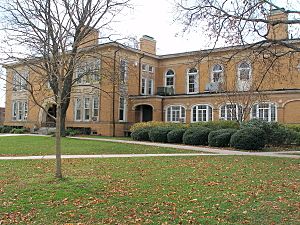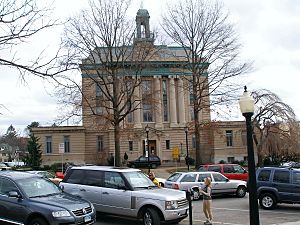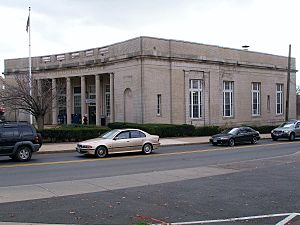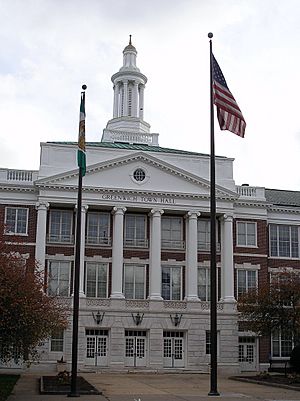Greenwich Avenue Historic District facts for kids
Quick facts for kids |
|
|
Greenwich Avenue Historic District
|
|

Greenwich Avenue, around 1910
|
|
| Location | Downtown Greenwich, Greenwich, Connecticut |
|---|---|
| Area | 86 acres (35 ha) |
| Architect | Multiple |
| Architectural style | Late 19th And Early 20th Century American Movements, Late 19th And 20th Century Revivals, Late Victorian |
| NRHP reference No. | 89001215 |
| Added to NRHP | August 31, 1989 |
|
Greenwich Municipal Center Historic District
|
|
| Area | 21.6 acres (8.7 ha) |
|---|---|
| Built | 1892 |
| Architect | Multiple |
| Architectural style | Late 19th and 20th Century Revivals, Art Deco, Romanesque |
| NRHP reference No. | 88000579 |
| Added to NRHP | July 26, 1988 |
The Greenwich Avenue Historic District is a special area in Greenwich, Connecticut. It shows how the downtown part of Greenwich grew over time. This district was added to the National Register of Historic Places in 1989. It includes the Greenwich Municipal Center Historic District, which was recognized a year earlier. That part is known for its beautiful public buildings.
Most of the shops and buildings in the district were built in three main styles. These styles show the time period they came from. They include the Italianate style from the late 1800s, the Georgian Revival style from the early 1900s, and the Commercial style from after World War I. The district stretches along Greenwich Avenue. This is the main street in downtown Greenwich. It runs between U.S. Route 1 and the New Haven Line train tracks.
History of Greenwich Avenue
Greenwich was first settled in 1640. But the early homes were spread out in different small villages. In 1665, Greenwich officially became a town in Connecticut. Later, in 1672, some settlers bought a piece of land called Miossehasseky. This area, where Havemeyer Fields is today, was used to graze horses. So, the whole village soon became known as Horseneck.
By 1703, the town decided to hold its meetings in two places. One was Sound Beach, the oldest settlement. The other was Horseneck, because it was in the middle of the town. In 1760, a "Town House" was built for meetings. It was located where Putnam and Maple Avenue meet now.
Horseneck grew very fast in the mid-1800s. It changed from a farming village to a rich suburban community. Many people moved there to live but worked in New York City. This growth happened mostly because the New Haven Railroad built a train station at the end of Greenwich Avenue. Because of this fast growth, Horseneck became the Borough of Greenwich in 1854. A borough is like a smaller, self-governing part of a town. This new government helped build many new public buildings quickly after the Civil War. These buildings were placed on land that used to be empty farms. Around these public buildings, many shops and homes were also built.
The rapid building of public spaces was helped by trains and steamboats. These services made it easy for people to live in Greenwich and work in New York City. Some rich people from New York, called capitalists, also helped with their own money. Henry O. Havemeyer was one of the first. He gave money to build the Havemeyer Building in 1892. It was first used as a school.
Another kind person, Robert M. Bruce, and his sister Sarah E. Bruce, gave the Old Town Hall to the town. This building was finished in 1905 and is now the Senior Center. The heart of Downtown Greenwich was completed when the Havemeyer family gave land for a public park and a post office. The post office building was built in 1916.
In the 1800s, most shops were at the northern end of Greenwich Avenue. This was where the Boston Post Road was located. This part of Greenwich Avenue provided goods and services to the growing community. This included the area now known as the Fourth Ward. By 1882, sidewalks, streetlights, and water pipes were all in place.
In the early 1900s, Greenwich Avenue was paved. A streetcar line was also added. Many houses on Greenwich Avenue were moved to nearby streets. This made room for new commercial buildings. Shops continued to boom in the 1920s. This was partly because the New Haven Railroad line was made electric and had more tracks. By this time, the borough had become very important to the whole town of Greenwich. In 1932, the borough and town governments joined together. This created the modern town government of Greenwich.
The last empty lot on Greenwich Avenue was built on in 1947. An office building, now used by Fawcett Publications, was constructed there. Today, fancy shops have replaced older stores. Offices in existing buildings have been updated. But the look of the street is mostly the same. It still serves as the main shopping and public center of the town.
Where is the District?
The Greenwich Avenue Historic District is mostly a long, narrow area. It includes buildings on both sides of Greenwich Avenue. It starts from Putnam Avenue (U.S. Route 1) in the north. It goes all the way to the New Haven Line train tracks in the south.
In the middle, the district gets wider. This wider part is where the Greenwich Municipal Center district is located. This wider area goes east along Havemeyer Place to Millbank Street. It also goes west across Havemeyer Field to Field Point Road. The current Town Hall is located there.
The district also includes shops near Greenwich Avenue. These are along the north side of Putnam Avenue, the north side of Lewis Street, the south side of Bruce Park, and the north side of Railroad Avenue. There are two small areas on Greenwich Avenue that are not included. These areas have modern buildings. One is south of Putnam Avenue on the east side. The other is on the east side of the intersection with Fawcett Place.
Residential neighborhoods surround the north, east, and west sides of the district. Part of the northern residential area is in the Fourth Ward Historic District. To the south are the train tracks, the Connecticut Turnpike, and Greenwich Harbor.
The historic district covers about 86 acres in total. About 21.6 acres of this is part of the Municipal Center district. Of that, 16.8 acres are taken up by Havemeyer Field. There are 152 buildings in the district. 124 of these are considered important to the history and look of the area. The district was planned to include old shops and public buildings. These buildings show the fast growth of the borough of Greenwich between 1860 and 1940. It was also designed to leave out homes and newer commercial buildings.
Important Buildings to See
The Greenwich Avenue Historic District shows many different building styles. These styles were popular in small cities in Connecticut in the late 1800s and early 1900s. Greenwich Avenue is special because so much of its old street look is still there today. Here are some of the most important buildings and blocks:
- Havemeyer Building – This building is at 290 Greenwich Avenue. It was the first building constructed in the Greenwich Municipal Center Historic District area. It was designed by Loring & Phipps in a Richardsonian Romanesque style. It has a strong horizontal look. It also features a Syrian arch around the entrance and an arched porch in front of the auditorium. Henry O. Havemeyer, a kind person from New York, built it in 1892. It was originally a public school called the Havemeyer School. This building set the style for other new buildings in the Municipal Center district. In front of it are two memorials. One is for World War II and the Korean War (built 1956). The other is for Col. Raynal Bolling (built 1921). Today, the Greenwich Board of Education uses this building.
- Greenwich Senior Center (Old Town Hall) – This building is across the street from the Havemeyer Building at 299 Greenwich Avenue. It was designed in the Beaux Arts style by Mowbray and Uffinger. It was built in 1904 to be the Town Hall of Greenwich. The building is three stories tall and shaped like a cube. The first floor has a rough stone look. The roof has a copper edge and a clock tower with a dome. Robert M. Bruce, another kind person from New York, built it. He gave it to the town in 1905 when it was finished. This building is also listed separately on the National Register of Historic Places.
- Greenwich Main Post Office – The main Post Office in Greenwich was built in 1916. The land for it used to belong to the Havemeyer family. They sold it to the U.S. government in 1909 specifically for a post office. The building is one story tall and designed in a classical revival style by James A. Wetmore. It has a curved front that fits the sharp corner where Greenwich Avenue and Arch Street meet. The area in front of the building is a public park. It has a World War I memorial built in 1927. This post office is also listed separately on the National Register.
- Greenwich Town Hall – The current town hall is at 101 Field Point Road. It is across Havemeyer Field from the Havemeyer Building. It was built in 1925 as the town's second high school. This three-story building is in a Georgian Revival style. It was designed by Guilbert and Betelle. It has a large, two-story entrance supported by columns. The building became the town hall in 1977.
- Town Hall Annex – This building was built in 1906 as the town's first high school. It is a classical revival design by Wilson Potter. The building has a three-story middle part with two shorter wings on the sides. It is located at 27 Havemeyer Place.
- Smith Building – The Smith Building at 289–295 Greenwich Avenue is one of several commercial buildings. It matches the classic styles of the Municipal Center buildings. It was built in 1906 for law offices. It has a Georgian Revival / Italian Renaissance design with classic arches and columns.
- Shreve, Crump & Low Building – Another building with a classic style is the Shreve, Crump & Low building at 125 Greenwich Avenue. It is a very detailed example of the Classical Revival style. It looks like ancient Greek architecture made of stone.
- 300 block of Greenwich Avenue – This block of Greenwich Avenue shows commercial buildings from the early 1900s. They are in the Georgian Revival and Classical Revival styles. This area is well-preserved, and many of the original shop fronts are still there. The buildings on this block are across from the Post Office. They were mostly built between 1910 and 1914.
- Greenwich Trust Bank – Located at 94-96 Greenwich Avenue, the Greenwich Trust Bank building was built in 1887. It is in the Queen Anne style. It has an unusual, uneven roofline. This building looks very different from its neighbor, an 1893 building that was changed in 1931 to have an Art Deco look.
- Fred Knapp Building – The Fred Knapp Building at 269 Greenwich Avenue is in a Late Gothic Revival style. It was built in 1906. The building has fancy limestone decorations on its shop front and roof edge. This makes it very unique. It stands out next to its newer Queen Anne style neighbor.
- Greenwich Police Department – This building at 11 Bruce Place was first built in 1925 as a garage. The Greenwich Police Department has been located here since 1968. It was not part of the original Municipal Center district because it was a commercial building. In recent years, the building has been greatly updated. During that time, the police department worked out of the Central Fire House next door.
- Greenwich Fire Headquarters – The Central Firehouse has been the main building for the Greenwich Fire Department since it was built in 1938. It is designed in the Art Deco style by Joseph W. Bailey. This three-story limestone building is different from the classic styles of other buildings in the Municipal Center district. The Greenwich Police Department also shared this building when their building was being renovated. Located at 15 Havemeyer Place, this large firehouse had five garage bays. It was home to several fire companies. As of 2012, the fire department moved, and the building was taken down after almost 75 years of service.
- St. Mary's Parish Center – The parish center at 200 Greenwich Avenue is a modern building. It was designed to fit in with the historic area. Its upper floor is set back to match the size of its neighbors. It also looks similar to the Beaux Arts style 1916 Greenwich Trust Building. The church offices are on the second floor, and the first floor has shops for rent. The parish center was built in 1986. It is not considered a "contributing" property to the historic district. However, it is important because it was designed to blend in with the older buildings around it. The parish center is connected to St. Mary's Roman Catholic Church and Rectory. This is one of only two churches in the district.
- Commercial blocks at Bruce Park Avenue and West Putnam Avenue – The Bruce Park Avenue block has four commercial buildings at the south end of the district. These buildings were built between 1899 and 1919 in different styles. The West Putnam Avenue block shows the Tudor Revival style. This style was popular after World War I.









